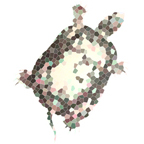![]()
ROBERT STEBBINS’S MEMORIES
Written when he was 95 years old.
There is no logical nor chronological order to the memories.
Post 9
![]()
Hunting Salamanders is Not Child’s Play!
I stood at his bedside as he muttered, “Don’t let anybody tell you hunting salamanders is child’ play” — words spoken by my graduate student Joe Gorman who had chosen to study salamanders as his doctoral thesis. He was in U.C. Berkeley’s Cowel Hospital Emergency ward recovering from assorted injuries resulting from a fall in a limestone cave in Northern california. As his major professor I was not immediately surprised because I knew he was prepared to take risks to learn all he could about his chosen subject –salamanders of the genus Hydromantes. This was a group of terrestrial salamanders known only, at the time, from isolated populations in Europe and a single species in the Sierra Nevada of California, a remarkable distribution! As I listened to the story of the accident I decided I must go to the site to learn more about what had happened.
Joe and his wife had gone to an area of limestone in the Mount Shasta region to look for Hydromantes. A U.C. Berkeley paleontologist, C. L. Camp, famous for his work on fossils in the area, had received a batch of shriveled up salamanders that had been found at one of the limestone sites in the area. He suspected that they might be a new species and contacted Joe to inform him of the find. The locality was far north of the Sierran form.
Joe was delighted, and with his wife Jerry and their small dog (an important player in this drama), went to the general area of the site. At this point my information on how Joe found the cave is lacking. I recall a steep slope with limestone outcrops and scattered clumps of brush. Had he been guided there or had he stumbled onto the cave as he explored the surrounding wild terrain. Caves, often concealed by vegetation, are sometimes located by the flow of cool air expelled through openings at the surface.
My Personal Observations at the Cave Site
The vicinity of the cave was somewhat brushy, mixed with limestone exposures. The entrance was a horizontal tunnel, perhaps 20 ft. long, and ending where a cavern opened up and dropped off into darkness. I shivered as I looked down into this dark foreboding area, wondering how Joe must have felt as he fell into the unknown.
At the entrance to the cave Joe began writing notes. A thorough observer, he might have spent an hour or so (?) at the task. Furthermore, he was visually in a twilight zone. As he started to leave, he somehow lost his orientation and instead of moving toward the exit, he moved in the opposite direction and fell into the abyss.
By measurement, I found (see sketch) that he fell 60 feet down a steep shaft before he hit bottom — the first 10 feet or so a free fall. He lost consciousness and, as I recall, was out for about 1 5 minutes. He knew the time span because of his notes, and his flashlight and wristwatch both had survived the fall.

When I studied the cave with the help of a rope, I could not imagine how he could have gotten out without help, especially given his injuries. The most difficult part would have been the “vertical drop” following the entrance turmel. I experimented at that site without the rope yet I could not find a way to get past that barrier. What a human being can do when life depends on it!
What happened when Joe reached the floor of the entry tunnel? He must have been exhausted and may have passed out again. It is doubtful if Jerry knew precisely where he had gone. What I know is the little dog was there to greet him! Had Jerry sent him, or had he gone on a hunt of his own? Finding Joe, did he enliven him by licking his face? As a person fond of dogs, I like to think so. Joe loved his little dog. Joe slipped a pencil under the dog’s collar, patted him and said “Go get Jerry”. Without this little canine’s help, this story may have had a less pleasant outcome.
This event occurred one mile east of Squaw Creek Road, vicinity of Low Pass Creek Road, Shasta County, california — on the west side of the Hosselkus.
![]()
Editor’s Note: With the exception of minor typographical and editorial corrections, all efforts have been taken to preserve Dr. Stebbins’ text as originally recorded.
For more information on this serial column featuring the life and times of Dr. Robert C. Stebbins, please visit this post.
![]()

